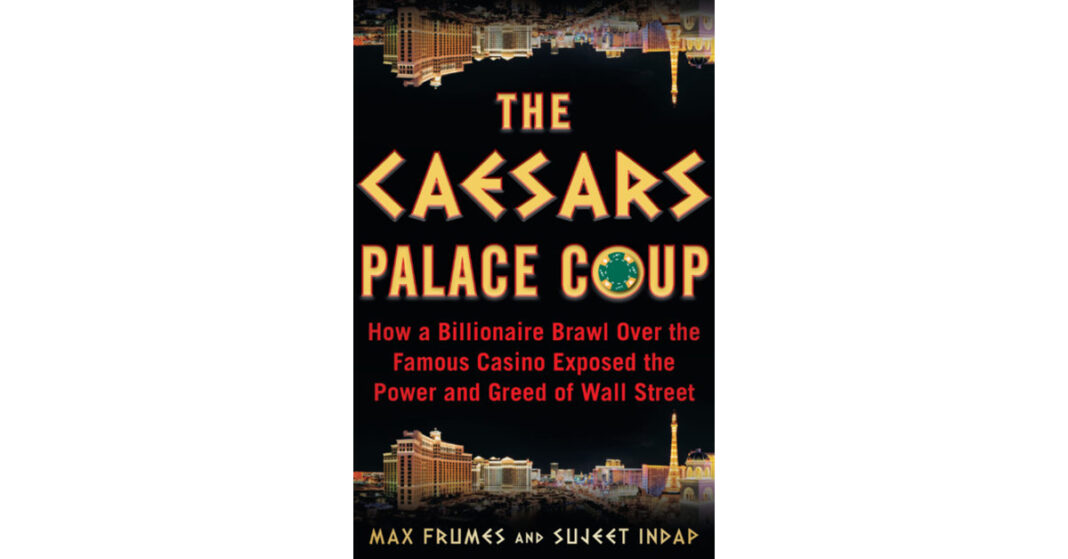The Caesars Palace Coup: How a Billionaire Brawl Over the Famous Casino Exposed the Power and Greed of Wall Street. 2021. Max Frumes and Sujeet Indap. Diversion Books.
Bankruptcy law trumps contract law in the United States. When you obtain a mortgage loan, issue bonds, sign a lease, or enter into an employment contract, the transaction is fully under the auspices of the United States and all of its laws, including specification of the debtor’s right to file for bankruptcy protection.
Max Frumes and Sujeet Indap convey this fundamental legal concept in The Caesars Palace Coup: How a Billionaire Brawl Over the Famous Casino Exposed the Power and Greed of Wall Street, a real-life narrative of the January 2015 $18 billion Chapter 11 (reorganization) bankruptcy filing under the US Bankruptcy Code of Caesars Entertainment Corp.’s main operating unit, Caesars Entertainment Operating Company, Inc. (CEOC).
A leveraged buyout of Caesars by Apollo Global Management and TPG Capital completed just prior to the 2008–2009 global financial crisis resulted in the casino-entertainment provider entering Chapter 11 bankruptcy protection in early 2015. This bankruptcy pitted aggressive and deep-pocketed distressed debt hedge funds (creditors) against private equity owners Apollo and TPG. These creditors included first-lien bank loan holder GSO Capital Partners, first-lien bondholder Elliott Management Corporation, and second-lien bondholders Appaloosa Management and Oaktree Capital Management.
The book provides a fascinating inside account of the distressed debt markets, including the strategies, the colorful personalities, and the complex relationships. In lieu of buying undervalued stock, these risk-taking hedge funds pay 50 to 70 cents on the dollar in order to gain controlling stakes in troubled companies.
US bankruptcy laws are considered very “borrower-friendly,” as opposed to UK and Canadian bankruptcy laws, which are very “lender-friendly.” In January 2017, CEOC won court approval for a plan to shed $10 billion of debt and separate its US-based property assets from its gaming operations. The company eventually emerged from bankruptcy in October 2017. As part of the reorganization plan, Caesars Entertainment merged with another subsidiary, Caesars Acquisition Co., with a view to regrouping its casinos and hotels under one roof. This new group was positioned to attract new business from millennials to offset an expected slowdown in its traditional slot machine business as baby boomers retire. Apollo and TPG ultimately retained a 16% collective stake in the new Caesars, which was controlled by creditors, but did not own any equity in the REIT that housed the property assets.
The primary takeaway from this book for business and finance practitioners is the potential for creating value through corporate restructuring. Corporate restructuring is a significant event affecting not only lenders, shareholders, and employees but also the relationships between companies and their corporate customers, suppliers, and competitors. It is the process by which companies renegotiate the financial contracts they have entered into with their creditors and other stakeholders, typically in response to a financial challenge. Corporate restructuring effectively represents a “re-slicing of the corporate pie” or fixing of a “sick” capital structure.
In the Caesars Chapter 11 bankruptcy, the distressed debt investors were not just financially astute. They also weaponized the law, using their knowledge of dense legalese in loan agreements and bond indentures to gain the upper hand in boardroom negotiations and in courtroom showdowns.
Many readers of the book will be highly critical of the scorched earth tactics of Apollo, its allies, and its lawyers and lobbyists. By 2015, in the view of Frumes and Indap, such private equity firms as Apollo had become highly abusive of creditors, wielding legal documents and hardball negotiating tactics to “take” value from loan and bondholders that did not rightly belong to them. The creditors all sought to maximize their recoveries, with senior creditors set to receive over 100% and junior creditors allocated closer to 65 cents on the dollar.
The book describes how in the final hours, the senior Caesar creditors were essentially begging Oaktree and Appaloosa (the second-lien bondholders) to back off their aggressive efforts, which were imperiling a delicate compromise with Apollo.
Ultimately, this book provides a superb account of what modern high finance and the distressed debt markets are actually like, depicting the bitter financial and courtroom warfare as well as the stress and shouting. It recounts a fascinating story of the clash of distressed debt hedge funds battling private equity giants for their share of an iconic Las Vegas casino conglomerate.
If you liked this post, don’t forget to subscribe to the Enterprising Investor.
All posts are the opinion of the author. As such, they should not be construed as investment advice, nor do the opinions expressed necessarily reflect the views of CFA Institute or the author’s employer.
Professional Learning for CFA Institute Members
CFA Institute members are empowered to self-determine and self-report professional learning (PL) credits earned, including content on Enterprising Investor. Members can record credits easily using their online PL tracker.



